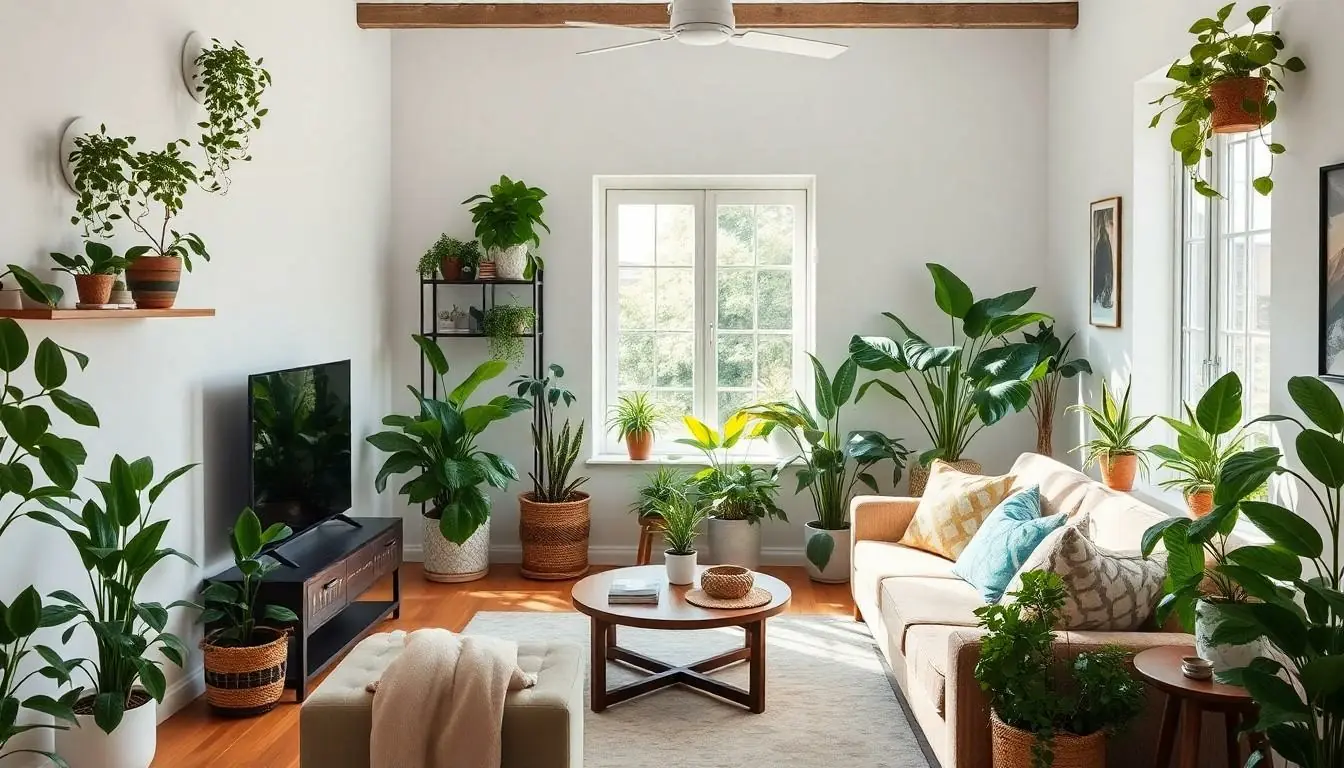Foliage house plants are like the cool kids of home decor. They don’t just sit there looking pretty; they bring life and personality to any space. Imagine a lush green friend in the corner, silently judging your Netflix choices while also purifying the air. Who wouldn’t want that kind of company?
These leafy companions are more than just Instagram fodder. They’re low-maintenance, thriving on neglect, and perfect for anyone who’s ever managed to kill a cactus. Whether you’re a plant whisperer or a serial plant killer, there’s a foliage plant out there waiting to transform your home into a verdant oasis. Dive into the world of foliage house plants and discover how they can elevate your living space while keeping things fresh and fun.
Table of Contents
ToggleOverview of Foliage House Plants
Foliage house plants stand out for their lush greenery and aesthetic appeal. They include varieties such as pothos, snake plants, and philodendrons. These plants thrive in various indoor conditions, making them an ideal choice for different environments.
Air purification is one of the significant benefits they offer. According to a study by NASA, certain foliage plants can remove toxins like formaldehyde and benzene from the air. With this ability, they contribute to healthier indoor spaces, which is essential for well-being.
Low maintenance characterizes most foliage house plants, appealing to both novice and experienced plant owners. They require minimal watering and can often adapt to lower light conditions. For example, a snake plant can survive in indirect sunlight and only needs watering every few weeks.
A diverse range of sizes and shapes allows for creative arrangements and decorations. Homeowners can mix and match plants to enhance their decor and create focal points. Tall plants like fiddle leaf figs add height, while smaller varieties, such as spider plants, can fill shelves and tabletops.
Affordability often makes foliage plants accessible to many. They are available at local nurseries and garden centers, with prices varying based on size and rarity. Small plants typically range from $5 to $30, while larger specimens may cost more.
Foliage house plants enhance interiors with their visual appeal, resilience, and health benefits. By choosing the right plants, individuals can cultivate a vibrant, refreshing atmosphere in their homes.
Benefits of Foliage House Plants

Foliage house plants offer numerous advantages that enhance indoor environments. Their presence improves aesthetics, purifies air, and contributes to psychological well-being.
Aesthetic Appeal
Foliage plants bring life to any room. Various species, such as pothos and philodendrons, feature unique shapes and vibrant greens, making them visually striking. Placing these plants in strategic locations creates inviting atmospheres. Height variations allow for interesting arrangements, establishing dynamic focal points. Mixing different plants can lead to personalized decor styles, ensuring homeowners achieve desired looks. Overall, the aesthetic value of foliage plants significantly elevates living spaces.
Air Purification
Foliage plants play a vital role in improving indoor air quality. These plants absorb harmful toxins, including formaldehyde and benzene, through their leaves and roots. Research indicates that certain species, such as snake plants, effectively reduce airborne pollutants. Enhancing air quality promotes healthier living conditions. Additionally, better air circulation contributes to overall comfort within homes. Choosing a variety of foliage plants maximizes their air-purifying potential.
Psychological Benefits
A connection to nature enhances psychological health. Foliage house plants reduce stress and boost mood, contributing to improved emotional well-being. Studies demonstrate that simply being around plants can lower anxiety levels. Engaging with greenery promotes mindfulness, fostering relaxation and focus. Creating a tranquil environment with foliage plants supports mental clarity and encourages creativity. Integrating these plants into living spaces significantly enhances quality of life.
Popular Types of Foliage House Plants
Foliage house plants come in various types, each offering unique benefits and features. Three popular varieties include the snake plant, pothos, and spider plant.
Snake Plant
Snake plants thrive in low light and require minimal watering. Their upright leaves, often variegated, add striking visual interest to any room. Capable of surviving neglect, these plants filter indoor toxins like formaldehyde. Ideal for beginners, snake plants adapt well to diverse conditions, making them a favorite among plant enthusiasts.
Pothos
Pothos plants exhibit trailing vines that can create stunning displays. This type is particularly resilient and tolerates low light, which makes it suitable for various spaces. It’s widely known for its air-purifying abilities, effectively removing pollutants. Easy to propagate, pothos plants offer endless opportunities for sharing with friends or expanding one’s collection.
Spider Plant
Spider plants feature long, arching leaves that provide an appealing aesthetic. They produce “baby” spiderettes that can easily be replanted, allowing propagation. Resilient and adaptable, these plants thrive in bright, indirect light while tolerating lower light levels as well. Their capability to purify air adds to their popularity in households, making them a perfect choice for many indoor environments.
Care Tips for Foliage House Plants
Caring for foliage house plants ensures their longevity and vibrancy. Proper attention to water, light, and fertilization plays a crucial role in keeping them healthy.
Watering Requirements
Watering foliage house plants requires a balance to prevent overwatering or underwatering. Checking the top inch of soil helps determine moisture levels. Many plants thrive in slightly dry conditions between waterings. It’s advisable to water when the soil feels dry to the touch. Draining excess water from pots prevents root rot and promotes healthy growth. Monitoring the plant’s response over time enables adjustments to watering frequency based on environmental conditions.
Light Conditions
Light conditions vary for different foliage plants. Most thrive in indirect light, while others tolerate lower light levels. Placing plants near windows with filtered sunlight fosters healthy growth. Many foliage plants adapt to various lighting situations, but prolonged exposure to direct sunlight may scorch leaves. Adjusting plant placement according to seasonal light changes helps maintain ideal growing conditions. Observing leaf color and growth direction can indicate if the light requirements are being met.
Fertilization Practices
Fertilization practices support foliage house plant health. Using a balanced liquid fertilizer during the growing season boosts nutrient availability. Monthly applications typically enhance growth without overwhelming the plant. Diluting the fertilizer to half strength can prevent potential damage from over-fertilization. During the dormant season, reducing or halting fertilization allows plants to rest and conserve energy. Assessing plant health periodically ensures that fertilization aligns with growth stages and specific needs.
Foliage house plants offer a unique blend of beauty and functionality that can transform any living space. Their ability to purify the air while enhancing decor makes them invaluable companions in modern homes. With a variety of options available, even those new to plant care can find suitable choices that thrive with minimal effort.
Incorporating these plants into a home not only improves aesthetics but also promotes a healthier and more uplifting environment. As they flourish, they bring a sense of tranquility and joy, making every room feel more inviting. Embracing foliage plants is a simple yet effective way to elevate one’s living space and well-being.






